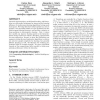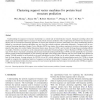1500 search results - page 70 / 300 » Advances in computational intelligence and learning |
DIGITEL
2007
IEEE
15 years 4 months ago
2007
IEEE
Distributed Computational Toys are physical artifacts that function based on the coordination of more than one computing device. Often, these toys take the form of a microcontroll...
ATAL
2006
Springer
15 years 1 months ago
2006
Springer
Factored representations, model-based learning, and hierarchies are well-studied techniques for improving the learning efficiency of reinforcement-learning algorithms in large-sca...
ESWA
2007
14 years 9 months ago
2007
Understanding the sequence-to-structure relationship is a central task in bioinformatics research. Adequate knowledge about this relationship can potentially improve accuracy for ...
ICMCS
2006
IEEE
15 years 3 months ago
2006
IEEE
We believe handwriting input may be able to provide significant advantages over typing, especially in the mathematics learning domain. The use of handwriting may result in decreas...
ISMIS
2005
Springer
15 years 3 months ago
2005
Springer
With the rapid advancement of information technology, scalability has become a necessity for learning algorithms to deal with large, real-world data repositories. In this paper, sc...


